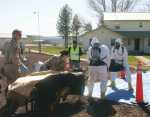State units practice terrorism exercise in Hammett

In a cooperative effort between the BLM, fire department personnel from Caldwell and Boise, and the Idaho National Guard's 101st Civil Support Team, the BLM fire station in Hammett became the scene of a full-scale terrorism exercise on Friday, April 12.
Although invited to participate, representatives with the Elmore County Sheriff's Office did not attend the exercise. Sheriff Rick Layher later explained that his deputies have been extremely busy partly because of a reduced workforce. Currently, the department is short three deputies who are on light-duty due to injuries. Prior commitments also prevented deputies from attending the training exercise.
No other local emergency response teams (fire or ambulance) were invited to participate.
The BLM offered use of its Hammett facility in response to the CST's desire to hold an exercise in the southern Idaho area. The agency's involvement included providing the training facility and being part of the observation team. The BLM also volunteered one of its employees to act as a victim of exposure to a caustic substance in order for CST medical personnel to gain some training time.
There are 57 CST teams throughout the United States as well as in the nation's commonwealths of Guam, the Virgin Islands and Puerto Rico, noted John McKenzie owner of Trident Consulting, LLC. The Boise-based firm designs emergency training exercises specific to their client's needs and furnishes training equipment.
At the request of the governor, the CST can be mobilized to assist local first responders with situations that go beyond their expertise and resources.
Only a few of the participants involved during the training knew the dynamics of the scenario beforehand. Observers from all participating entities followed along as first responders and CST members worked through the exercise.
What first appeared to be the discovery by a cleaning person of a meth lab in a storage shed eventually evolved into a full-scare terrorist threat as the scenaria was played out.
As CST and fire department HAZMAT teams searched the premises, they would soon discover materials, notes, maps, distilling equipment and other items that would point to a much larger threat.
McKenzie said CSTs are required to hold at least one exercise a year.
This is the first time such an exercise has been held in Hammett.
CST members must have 900-1000 hours of training before they can certify for the team, said Col. Timothy Marsano, Public Affairs Office for the Idaho National Guard.
The 101st brought along an armada of vehicles containing an impressive array of technology. Marsano noted that the vehicles are not 4-wheel drive, as one might expect. Their typical 2-wheel drive profile allows the trucks to be transported in C-130s.
A communication truck with an on-board satellite dish has equipment that allows CST to communicate with anybody -- from the president to the head of the FBI -- regardless of where the team might find itself, even if that is in the backwoods of Idaho.
Another vehicle is equipped with GIS (Geographic Information System) and mapping equipment capable of generating up-to-the-moment aerial views of the scene as the operation unfolds.
Part of the equipment includes a plotter that produces geographical images. Overlays showing up-to-date wind direction and other pertinent atmospheric conditions provide the incident commander with information needed to direct evacuation efforts for at-risk citizens.
Also a part of the CST arsenal is a mobile lab that allows team members to identify the make-up of any substances, a de-contamination truck with an on-board water supply, de-con tents, HAZMAT suits as well as an impressive array of dedicated monitoring and detecting equipment.
An after-action review with all the participants was held on Monday.
Marsano said the feedback was positive. The training exercise was videotaped and Trident will supply a copy of the CD to all participating agencies.
